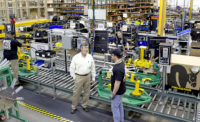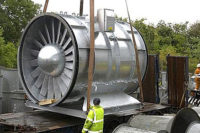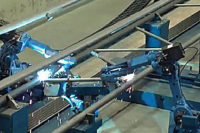Finding and using new technology has been a constant guiding principle for Twin City Fan and Blower (TCFB) throughout its nearly 40-year history. This approach has spurred continual company growth, leading to TCFB opening four South Dakota plants where it manufactures an extensive line of high-quality industrial and commercial fans.
The company’s fans are often used for ventilation. Simple stamped-blade models are common in restaurants, while complex systems are designed for coal mines. Other fans are used for drying grain, or transporting cereal or materials in a manufacturing process. The Metrodome in Minneapolis uses the fans to maintain constant air pressure and hold up the roof.
In 2011, TCFB began researching the latest technology in robotic welding because the company had trouble finding qualified welders. TCFB also felt that robotic welding would help them meet growing demand, reduce production costs, improve plant efficiency and reduce operator fatigue.
TCFB welds impellers, pedestals and housings made of mild steel, stainless steel and aluminum to produce fans having 12- to 100-inch-diameter wheels. Those made of mild steel feature 14-gauge and heavier material. Aluminum wheel material thickness is 0.1 inch and greater. Heavy-duty fans require metal housings as thick as 0.375 inch.
As part of its research, TCFB met with Reis Robotics at its U.S. and German facilities. Eventually TCFB selected the six-axis RV20-16 robot, which was set up to work with two programmable RDS 11 positioning stations.
The robot arm is mounted on a rotating pedestal that enables welding of a different assembly in each station. The stations swivel and rotate, providing operators two more axes of robotic control and greater welding access.
The stations also lessen operator fatigue by making it easier for them to manually mount and weld the fan impellers and pedestals. Less operator fatigue means greater accuracy, which is critical when welding spinning parts such as fan vanes with varying pitches and contours.
TCFB also likes the RV20-16’s automated torch neck changer, which allows operators to weld at several different an-gles. During welding, the robot maintains proper weld speed regardless of torch angle.
“It doesn’t matter how fast the fan wheel is turning or how the robot is moving,” says Craig Vostad, robotics technician at Twin City Fan and Blower. “All you need to care about is that the seam remains in position.”
The RV20-16 has a maximum payload of 16 kilograms, with an additional 10-kilogram load on axis 3. Axis velocity ranges from 150 to 500 degrees per second, axis motion from 246 to 720 degrees. The robot has a maximum reach of 3,000 millimeters and repeatability of ±0.05 millimeter.
The RV20-16 can also be used for path welding; thermo-cutting; handling and palletizing; interlinking and loading; seal-ing, coating and gluing; mounting and joining; and die casting, gravity die casting and injection-molding automation.
For more information on robotic welders, call 847-741-9500 or visit http://reisroboticsusa.com.
Welding Robot Positions Fan Manufacturer for Continued Growth

The Metrodome in Minneapolis uses fans from Twin City Fan and Blower to maintain constant air pressure and hold up the roof. Photo courtesy www.baseball-reference.com


